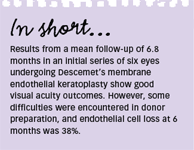Article
Early series highlights newest endothelial keratoplasty technique
Initial clinical results indicate the safety and efficacy of DMEK as a minimally invasive alternative for eyes requiring transplantation because of dysfunctional endothelium
Initial clinical results indicate the safety and efficacy of Descemet's membrane endothelial keratoplasty (DMEK) as a minimally invasive alternative for eyes requiring transplantation because of dysfunctional endothelium.

Dr Fogla reported outcomes from a prospective, interventional case series including six eyes of six patients (mean age 59 years). Data available from a mean follow-up of 6.8 months (range 6–9 months) showed improvements in uncorrected visual acuity (UCVA) and best-corrected visual acuity (BCVA) were achieved by all eyes. There were no graft rejections, but one eye required donor re-attachment, endothelial cell loss at 6 months averaged almost 38% and a few complications were encountered during donor preparation.
"Technique modifications … may make DMEK the procedure of choice for endothelial keratoplasty in the future," he said.
Specifics of approach

After securing the wound, the cornea is tapped from the surface until the donor opens with the correct orientation. Then the chamber is filled completely with air for 30 minutes. A bubble of at least 50% is left behind to support the graft. By 3 days after the procedure, the cornea is clear, he said.

Mean UCVA was 20/400 preoperatively and improved to 20/60. Mean BCVA improved from 20/200 to 20/40+ for the series.
"These eyes achieved good functional recovery, although there were some limitations beyond our control due to refractive error and pre-existing macular pathology," Dr Fogla said. "Five of the six eyes had 20/40 or better BCVA, but BCVA was only 20/80 in the sixth [eye] due to macular pathology."
Endothelial cell count for the donor material averaged 2,428 cells/mm2 preoperatively and had decreased to 1,510 cells/mm2 at 6 months, representing an endothelial cell loss (ECL) of 37.8%.
Complications encountered included damage to the donor Descemet's membrane during preparation in two cases and a partial peripheral Descemet's membrane detachment that required repositioning with reinjection of air.
"In the cases where there was damage during donor preparation, the corneas were from donors older than 70 years of age," he said. "Descemet's membrane is more fragile in these older eyes."
Dr Fogla said that the outcomes achieved in this initial small group of eyes compare favourably with those reported by Melles et al. in papers published in 2008 and 2010, especially with respect to visual acuity outcomes. However, in the 2010 paper, which included data from 50 eyes, the ECL rate at 6 months was 30%.
"The slightly higher average ECL in our series may be attributed to our earlier place on the learning curve," Dr Fogla concluded.
Newsletter
Don’t miss out—get Ophthalmology Times updates on the latest clinical advancements and expert interviews, straight to your inbox.




